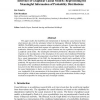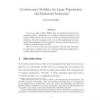509 search results - page 6 / 102 » Dynamic Modeling in Inductive Inference |
JMLR
2010
13 years 2 months ago
2010
This paper studies the feasibility and interpretation of learning the causal structure from observational data with the principles behind the Kolmogorov Minimal Sufficient Statist...
MKM
2004
Springer
14 years 1 months ago
2004
Springer
We describe an extension of first-order logic with sequence variables and sequence functions. We define syntax, semantics and inference system for the extension so that Completen...
MOR
2006
13 years 7 months ago
2006
It has been shown (Hart [2002]) that the backward induction (or subgame-perfect) equilibrium of a perfect information game is the unique stable outcome for dynamic models consisti...
AUSAI
1998
Springer
13 years 11 months ago
1998
Springer
Naive Bayesian classi ers utilise a simple mathematical model for induction. While it is known that the assumptions on which this model is based are frequently violated, the predic...
UMUAI
2008
13 years 7 months ago
2008
Abstract. Self-efficacy is an individual's belief about her ability to perform well in a given situation. Because selfefficacious students are effective learners, endowing int...


